SESSION-1: EMERGING ISSUES IN MERGER DEALS AND TAKEOVERS
10:25 AM: INAUGURATION
Professor Amit Kumar Kashyap, faculty coordinator and convenor of CCLS, the Institute of Law, Nirma University cordially welcomed our chief guests.
10:25 AM: INAUGURATION
Professor Amit Kumar Kashyap, faculty coordinator and convenor of CCLS, the Institute of Law, Nirma University cordially welcomed our chief guests.

Dev Pandey, Chairperson, CCLS delved into the previous glimpses of Samanvaya 1.0 and CCLS as the center undertook the initiative to organize this conclave. He briefly explained the initiatives of The Corporate Law Blog (TCLB) and The Corporate Research Journal (CRLJ), besides describing the ICCF, and how the committee serves in the reflection of practical knowledge rather than theoretical knowledge, thus opening the floor for the conference.

Dr. Madhuri Parikh ma’am, Dean, and Director (I/c) of the Institute of Law, Nirma University took the conference forward with a warm welcome to the guests, appreciating this initiative of CCLS, and congratulating the team for the same. She deliberated over the increasing interest of students allowing for an active committee in the field of corporate law, and the necessity of clinical education to go hand in hand with theoretical knowledge. Through events like Samanvaya 2.0, young minds are ignited to practically understand the implications of theories which considerably help the attendees in their internships as well. She insisted that the students take advantage of this splendid opportunity for a fruitful session.
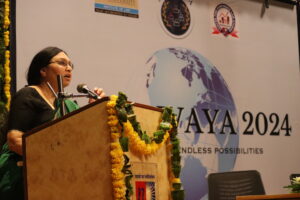
The panelists of the conclave were then introduced and Dr. Amit Kumar Kashyap was requested to give the esteemed guests a floral welcome. The dais consisted of Mr. Anupam Choudhary, Senior Associate, Shardul Amarchand Mangaldas and Co., Mr. Saurabh Sharma, Principal Associate, Cyril Amarchand Mangaldas, Adv. Jaimin Dave, High Court of Gujarat, and Mr. Kinjesh Thakkar, India Head- International Tax, Expatriate Tax & Transfer Pricing, Linde Engineering. The CRLJ journal for the academic year was unveiled by the guests.

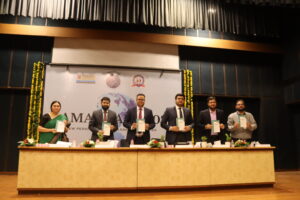
10:45 AM: PANEL SPEECHES BEGIN
The moderator, Mr. Anupam Choudhary opened the floor for discussion by briefly introducing the recent developments in the field of investments, and how India has come to be a hot belt for investment. In the last few years, several foreign insurers have been led to increasingly invest in India, leading to an increasing leaning towards liberalization. A national window system has been created to keep track of applications across various ministries. Now, a faceless system allows for ease of doing business. For example, the concept of roundtripping makes it easier for foreign companies to invest. Also, the transfer of shares and the costs for the same were brought under the radar under business law. There has been an increase in PE investors and international promoters in India. The last 3-4 years have been uncertain in the international spectrum as there has been an increase in the cost of capital, due to which deals are slowing down, and it leads to skepticism for PE investors. He speculated on the investment possibilities in GIFT City, concluding his insights on an affirmative note.
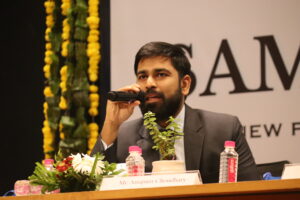
Mr. Saurabh Sharma then took the floor, questioning the students on their awareness of emerging issues in M&A, which is essentially contemporary. Data concerns, the necessity of incorporating themes such as renewable energy and social impact, and new-era issues, such as transportation of green hydrogen were discussed. The example of Sri Lanka, currently struggling with civil disruptions, etc. as against volatility of markets and whether the stability of the Indian sphere is truly beneficial was deliberated over. In an age where information is easily available at one’s fingertips, one must take the initiative to explore the trends to be truly aware of the markets.
It is imperative to read between the lines when it comes to news headlines, which must not be taken at face value. Taking the example of BlinkIt, he discussed how data collected could be used if ever a court case comes to be. Brand image preservation is extensively important to companies, and it is in doing so that their objectives are laid out- causing sways in markets owing to their variability. Thus, it is high time (for law students especially) to not just hear but truly read and learn for a comprehensive, holistic understanding of the processes at work.
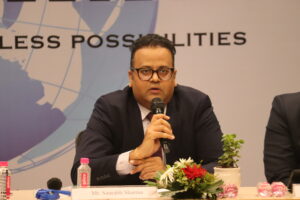
Mr. Jaimin Dave took the stage next to give a practical overview of the issues that come up in mergers and amalgamations. Four stages of the merger were discussed: merger and planning, approvals, approvals from ROC or NCLT (court approvals), and post-merger compliances. One of the major reasons for mergers and amalgamation is tax savings between two firms so that a loss-making company can carry forward its losses to the profit-making company, as was highlighted in McDowell’s case. He further talked about forward integration and backward integration. Secondly, mergers take place to reduce compliance costs. Lastly, operational synergy is also one of the reasons for amalgamations. He further talked about the practicability of the objectives set out in the scheme of amalgamation.
For example, in a scheme of amalgamation, a certain number of shares were split into two. When they went to the ROC for the same it was held not to be practicable. In cases of approvals, affidavits can be accorded in cases of amalgamations; in the case of an NBFC, however, for getting amalgamated with another NBFC you need to get the approval of the RBI. Every scheme of amalgamation has a cut-off or an execution date. The SEBI circular talks about the delay in getting approval from the execution date and its compatibility. Thus, the appointed date should be carefully selected so that there isn’t a delay.
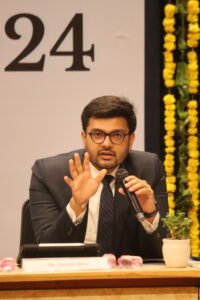
In relation to the NCLT’s approval, there exist a lot of problems due to the burden of NCLT from the IBC cases. Hence, it is very difficult to get one’s matter listed in the NCLT. Delays can occur in getting the approval of NCLT for these reasons. A lot of registered offices have been shifted to Gujarat solely for the purpose of mergers, as there is a maximum cap of 25 Crores in stamp duty: which is not the case in states like Mumbai. Even the shifting takes a lot of time and hence, there is a problem in implementation. Liability of the transferor will be taken by the transferee, which is one of the standard clauses in the scheme of mergers. Several other issues pertain to implementation, which include a particular asset being left out of the schedule in the order. Then it becomes really difficult to include them, as there is no provision for modifying the order under the Companies Act. A lot of mergers have been going through the IBC. An example exists wherein a private company may merge with a debtor publicly listed and then the merged company gets listed. Also, amalgamation may take place in the purview of the stamp duty. With the advent of foreign investors and the GIFT City, a large base exists for mergers in Gujarat. Some of the other contestations may come from the IT department and the regional heads, though.
Mr. Kinjesh Thakkar took the conference forward on a lighter note, thanking the contribution of the panelists who spoke before him. Dealing in taxation laws, he started by asking the audience to guess the tax percentage taken up by major companies: even when four of them accumulated, they contributed only about 0.1%. Therefore, tax plans often take a backseat when it comes to mergers and amalgamations. He distinguished between organic and inorganic routes of mergers, formulating the essence of strategic acquisitions that lead to value creation for investors and shareholders. Foreign companies are now allowed to have a subsidiary in India, allowing them to switch headquarters internationally- allowing for better valuation of such companies.
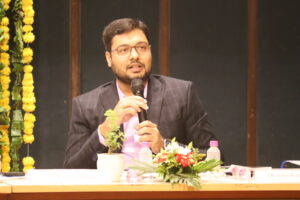
11:40 AM: PANEL DISCUSSION
Mr. Anupam Choudhary asked Mr. Saurabh Sharma to deliberate on international entities. He replied that there is a concept called funding ripping, which states the deals can’t be closed until the disputes in the states don’t settle, thus having a ripple effect on cross-border deals. Furthermore, the session moderator questioned Mr. Jaimin Dave regarding the mergers getting stalled due to regulatory incompatibilities, and the importance of due diligence in this regard when the companies want to get the merger done quickly, along with the nuances relating to it. In reply, he said that due diligence is of paramount importance and that a company can’t proceed without ensuring due diligence. Moreover, without effective due diligence, there is a chance of the creation of a lot of hurdles. Furthermore, there have been a few cases of deal breaks as there was no proper due diligence.
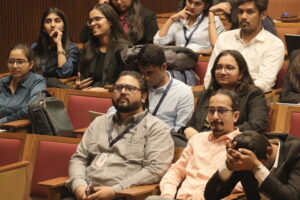
Lastly, Mr. Kinjesh Thakkar was questioned relating to the key consultations in a meeting relating to the merger. In reply, he said that the primary purpose of mergers or amalgamations was to try to either increase the scale, scope, or capabilities of the business at hand. The boardroom meetings primarily center around this, also deliberating over the chances of such business flourishing. The second stage is the number policy where all the figures are taken into consideration. The last stage is regarding the compliance issues relating to the project.
India has tax treaties essentially different from, for example, Mauritius. So, businesses often used to channel their investment through Mauritius for tax saving purposes. However, a business can’t keep an entity solely for tax-saving purposes; it is not just limited to the international spectrum but is also seen in the local boundaries. The tax treaties have thus been amended and an entity can’t be formed solely for saving taxes.
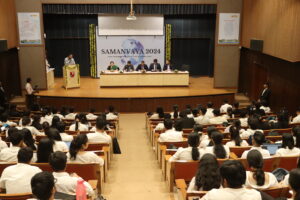
The first session of the conference then concluded with a round of insightful Q&A.
SESSION 2: TRENDS IN CORPORATE INSOLVENCY LAW AND PRACTICE
1:30 PM: PANEL DISCUSSION
Mr. Varun Akar, Assistant Manager at Grant Thornton Restructuring Services LLP served as the moderator for this session. The panelists included Mr. Sandeep Bhuraria, Senior Partner at Zeus Law; Mr. Somdutta Bhattacharyya, Partner at Argus Partners; and Mr. Saurav Panda, Partner at Shardul Amarchand Mangaldas & Co., each bringing extensive expertise in their respective fields to the discussion.
The second session commenced with Mr. Varun Akar setting the stage by focusing on recent trends in IBC and their grey areas. The major themes he laid out for the conference moving forward were the extinguishment of rights, real estate insolvencies, treatment of government dues, and the Vidarbha judgment.

Mr. Somdutta Bhattacharya carried the conversation forward, focusing on the determination of liabilities, recovery of dues, and the rights to enforce personal guarantees under Section 128 of the Indian Contract Act. A resolution plan is a contract between the creditors and the team, and it can’t come into contravention with a contract with a third party.
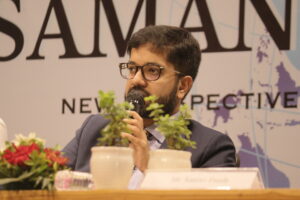
Mr. Saurav Panda insisted that contract laws don’t distinguish between different types of guarantees. He stated that the guarantees given by banks form the basis of trade transactions. The fundamental principle in this regard is that a guarantee creates an obligation coexistent with that of the debtor. He highlighted the potential harm of utilizing commercial wisdom to cancel guarantees in a complex global arena. The supremacy of the same emphasized by the Supreme Court does not account for third-party rights arising out of the contract.

Mr. Varun Akar moved next to real estate insolvency. About 21% of the insolvency cases fall in the bracket of real estate insolvency. Mr. Sandeep Bhuraria stated that real estate insolvency should have been a different chapter in the IBC altogether. The IBC was passed in May 2016. At that time, the creditors didn’t include allottees. Three major players were included in a suit: Unitech, JP, and Amrapally. After this, a movement was started to include allottees within the ambit of creditors, thus making them a part of CIRP. Courts have tried to make innovative ways to tackle the problem, with significant advancements in May 2020. A corporate debtor standing outside the scope of a debtor can fund the company and thereby infuse capital to pay off debts.
Secondly, project-wise insolvency was brought into picture. Real estate companies have multiple projects so there is a chance of unsuccessful CIRP. This alarming issue too doesn’t find a place in the vast IBC. Allotees of a particular failed project will only be applicable for a CIRP. He discussed various suggestions given by CIRP to tackle problems of real estate insolvency, a subject vast enough to constitute a separate research area itself. The resolution of these problems in the absence of a well-defined laid-down law thus becomes extensively difficult. When CIRPs are filed against landholding companies, group insolvency is the most probable solution. However, this is simply his insight as the Supreme Court is yet to come up with a judgment regarding the same.

Mr. Saurav Panda further discussed group insolvency, bringing up the fact that the UK is now recognizing the same. India too is developing its interpretations, experimenting with steps taken around group entities. Setting the context, he went on to discuss the liquidation waterfall. The benefit of being a financial creditor lets one decide their security status. The funding structure of real estate projects was then succinctly explained.
Section 55(6) creates a specific charge over the sale of immovable properties if assets are not forthwith given to you. It effectively creates an interest in the favour of the buyer. In a way, the homebuyer is a secured creditor with interest in the property, thus having a charge in the same. An argument insisting upon the same is thus not entirely without base. Their treatment in resolution plans is yet to be judicially scrutinized.
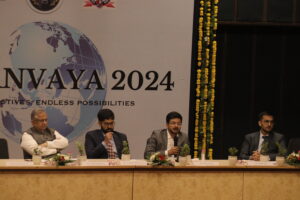
Mr. Soumdutta Bhattacharya thus built upon the same to insist that a new code on real estate insolvency is imperative to tackle the novel emerging issues. The home buyer suffers the most from the OCCC certificate and thus doesn’t get the default interest. The flat is to be granted on this basis. Thus, a new chapter or a separate code in conjunction with RERA is the need of the hour for real estate insolvency.
Mr. Varun Akar then opened the third topic dealing with government views that were put out under the BARC report. Mr. Saurav Panda took him up on the topic, starting with how IBC came about in 2016. The ultimate dues payable to banks and financial institutions were a recurring theme considering the state of the economy back then, which was on the brink of collapse. The way the law was structured, as can be seen in the preamble, was for the government to take a sort of a backseat. Categories of creditors came to be to segregate associated issues.
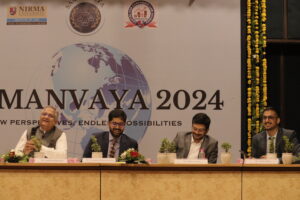
Operational creditors need to be given at least the value that they had given when the company went for liquidation. If one is just a government creditor, this value would almost be nil, and the government would not be able to recover any dues. The case of Rainbow Papers brought a change in this scene. The Supreme Court held that the charge in the statute is effectively a security interest, and the government is just a security interest holder. This created huge ripples in the legal arena. Justice Bhatt later laid down the law stating that the government must take a backseat and can’t claim as a secured creditor in this regard. Where matters become grey lies in them being division bench judgments. Today, as things stand, two judgments saying contradictory things stay, creating ambivalence and confusion. He hopes for clarity on the matter from a larger bench.
Mr, Sandeep Bhuraria further added that in the Prabhajit Singh case, the person under Section 131 of the IBC, is included in the ambit of the “creditor”. They bought the statutory rights on an equal pedestal with the contractual rights. Thus, more emphasis was to be placed on the legislative intent of the statute. Mr. Sandeep Bhattacharya added that in the backdrop of judicial activism, the waterfall approach creates discontent under Section 53 of the IBC, thus drawing an analogy with the arbitration conflict of stamping.
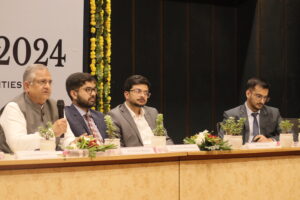
Mr. Saurav Panda closed this topic, stating that if companies undergoing insolvency have to prioritize government dues then there will be no money left for any other interested person. Thus, the working of the code will become unviable. Mr. Varun Akar then talked about the Vidarbha judgment. He briefly discussed the judgment and held that Section 7 is discretionary, that the NCLT can reject this application, and whether the stance of shifting to a balance sheet approach was correct or not.

Mr. Somdutta Bhattacharya in this context said that the balance sheet approach is not viable, and only the default of the company has to be looked into. There is a big question as to what are receivables. Thus, there should be a centrist approach by default, as was the approach in the Innovative Industries Case. Mr. Saurav Panda, in slight disapproval, emphasized that when the default-based approach was taken up, they were to be going down a certain, well-defined path- hence, the legislative intent shows that they wanted to go with the default approach. This creates a long pendency in the cases, although the legislative intent was to be an objective test. There is no certainty regarding the receivables. Thus, the judgment in question is not completely in line with the legislative intent. The success rate of insolvency in developed countries is because of the objectivity of principle application and hence a uniform approach is preferred.
Mr. Sandeep Bhuraria concluded the panel discussion by agreeing with Mr. Saurav Panda, stating that the Vidarbha judgment disregards the legislative intent. The inability to pay debts was the basis for the admission of debt before. The Section 7 petition is now hardly followed in the manner of its interpretation.
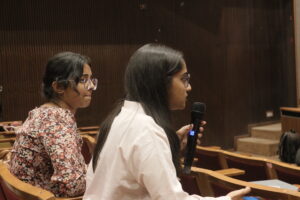
The session ended with a comprehensive Q&A dealing with the latest judgment of the Global Mercantile case, and those surrounding conflicting provisions of RERA and IBC. Finally, Mr. Kshitij Srivastava, External Relations Head (Corporate and Alumni), CCLS delivered the vote of thanks, thereby declaring the conference concluded.
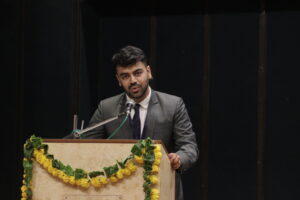

Dr. Madhuri Parikh ma’am, Dean, and Director (I/c) of the Institute of Law, Nirma University took the conference forward with a warm welcome to the guests, appreciating this initiative of CCLS, and congratulating the team for the same. She deliberated over the increasing interest of students allowing for an active committee in the field of corporate law, and the necessity of clinical education to go hand in hand with theoretical knowledge. Through events like Samanvaya 2.0, young minds are ignited to practically understand the implications of theories which considerably help the attendees in their internships as well. She insisted that the students take advantage of this splendid opportunity for a fruitful session.

The panelists of the conclave were then introduced and Dr. Amit Kumar Kashyap was requested to give the esteemed guests a floral welcome. The dais consisted of Mr. Anupam Choudhary, Senior Associate, Shardul Amarchand Mangaldas and Co., Mr. Saurabh Sharma, Principal Associate, Cyril Amarchand Mangaldas, Adv. Jaimin Dave, High Court of Gujarat, and Mr. Kinjesh Thakkar, India Head- International Tax, Expatriate Tax & Transfer Pricing, Linde Engineering. The CRLJ journal for the academic year was unveiled by the guests.


10:45 AM: PANEL SPEECHES BEGIN
The moderator, Mr. Anupam Choudhary opened the floor for discussion by briefly introducing the recent developments in the field of investments, and how India has come to be a hot belt for investment. In the last few years, several foreign insurers have been led to increasingly invest in India, leading to an increasing leaning towards liberalization. A national window system has been created to keep track of applications across various ministries. Now, a faceless system allows for ease of doing business. For example, the concept of roundtripping makes it easier for foreign companies to invest. Also, the transfer of shares and the costs for the same were brought under the radar under business law. There has been an increase in PE investors and international promoters in India. The last 3-4 years have been uncertain in the international spectrum as there has been an increase in the cost of capital, due to which deals are slowing down, and it leads to skepticism for PE investors. He speculated on the investment possibilities in GIFT City, concluding his insights on an affirmative note.

Mr. Saurabh Sharma then took the floor, questioning the students on their awareness of emerging issues in M&A, which is essentially contemporary. Data concerns, the necessity of incorporating themes such as renewable energy and social impact, and new-era issues, such as transportation of green hydrogen were discussed. The example of Sri Lanka, currently struggling with civil disruptions, etc. as against volatility of markets and whether the stability of the Indian sphere is truly beneficial was deliberated over. In an age where information is easily available at one’s fingertips, one must take the initiative to explore the trends to be truly aware of the markets.
It is imperative to read between the lines when it comes to news headlines, which must not be taken at face value. Taking the example of BlinkIt, he discussed how data collected could be used if ever a court case comes to be. Brand image preservation is extensively important to companies, and it is in doing so that their objectives are laid out- causing sways in markets owing to their variability. Thus, it is high time (for law students especially) to not just hear but truly read and learn for a comprehensive, holistic understanding of the processes at work.

Mr. Jaimin Dave took the stage next to give a practical overview of the issues that come up in mergers and amalgamations. Four stages of the merger were discussed: merger and planning, approvals, approvals from ROC or NCLT (court approvals), and post-merger compliances. One of the major reasons for mergers and amalgamation is tax savings between two firms so that a loss-making company can carry forward its losses to the profit-making company, as was highlighted in McDowell’s case. He further talked about forward integration and backward integration. Secondly, mergers take place to reduce compliance costs. Lastly, operational synergy is also one of the reasons for amalgamations. He further talked about the practicability of the objectives set out in the scheme of amalgamation.
For example, in a scheme of amalgamation, a certain number of shares were split into two. When they went to the ROC for the same it was held not to be practicable. In cases of approvals, affidavits can be accorded in cases of amalgamations; in the case of an NBFC, however, for getting amalgamated with another NBFC you need to get the approval of the RBI. Every scheme of amalgamation has a cut-off or an execution date. The SEBI circular talks about the delay in getting approval from the execution date and its compatibility. Thus, the appointed date should be carefully selected so that there isn’t a delay.

In relation to the NCLT’s approval, there exist a lot of problems due to the burden of NCLT from the IBC cases. Hence, it is very difficult to get one’s matter listed in the NCLT. Delays can occur in getting the approval of NCLT for these reasons. A lot of registered offices have been shifted to Gujarat solely for the purpose of mergers, as there is a maximum cap of 25 Crores in stamp duty: which is not the case in states like Mumbai. Even the shifting takes a lot of time and hence, there is a problem in implementation. Liability of the transferor will be taken by the transferee, which is one of the standard clauses in the scheme of mergers. Several other issues pertain to implementation, which include a particular asset being left out of the schedule in the order. Then it becomes really difficult to include them, as there is no provision for modifying the order under the Companies Act. A lot of mergers have been going through the IBC. An example exists wherein a private company may merge with a debtor publicly listed and then the merged company gets listed. Also, amalgamation may take place in the purview of the stamp duty. With the advent of foreign investors and the GIFT City, a large base exists for mergers in Gujarat. Some of the other contestations may come from the IT department and the regional heads, though.
Mr. Kinjesh Thakkar took the conference forward on a lighter note, thanking the contribution of the panelists who spoke before him. Dealing in taxation laws, he started by asking the audience to guess the tax percentage taken up by major companies: even when four of them accumulated, they contributed only about 0.1%. Therefore, tax plans often take a backseat when it comes to mergers and amalgamations. He distinguished between organic and inorganic routes of mergers, formulating the essence of strategic acquisitions that lead to value creation for investors and shareholders. Foreign companies are now allowed to have a subsidiary in India, allowing them to switch headquarters internationally- allowing for better valuation of such companies.

11:40 AM: PANEL DISCUSSION
Mr. Anupam Choudhary asked Mr. Saurabh Sharma to deliberate on international entities. He replied that there is a concept called funding ripping, which states the deals can’t be closed until the disputes in the states don’t settle, thus having a ripple effect on cross-border deals. Furthermore, the session moderator questioned Mr. Jaimin Dave regarding the mergers getting stalled due to regulatory incompatibilities, and the importance of due diligence in this regard when the companies want to get the merger done quickly, along with the nuances relating to it. In reply, he said that due diligence is of paramount importance and that a company can’t proceed without ensuring due diligence. Moreover, without effective due diligence, there is a chance of the creation of a lot of hurdles. Furthermore, there have been a few cases of deal breaks as there was no proper due diligence.

Lastly, Mr. Kinjesh Thakkar was questioned relating to the key consultations in a meeting relating to the merger. In reply, he said that the primary purpose of mergers or amalgamations was to try to either increase the scale, scope, or capabilities of the business at hand. The boardroom meetings primarily center around this, also deliberating over the chances of such business flourishing. The second stage is the number policy where all the figures are taken into consideration. The last stage is regarding the compliance issues relating to the project.
India has tax treaties essentially different from, for example, Mauritius. So, businesses often used to channel their investment through Mauritius for tax saving purposes. However, a business can’t keep an entity solely for tax-saving purposes; it is not just limited to the international spectrum but is also seen in the local boundaries. The tax treaties have thus been amended and an entity can’t be formed solely for saving taxes.

The first session of the conference then concluded with a round of insightful Q&A.
SESSION 2: TRENDS IN CORPORATE INSOLVENCY LAW AND PRACTICE
1:30 PM: PANEL DISCUSSION
Mr. Varun Akar, Assistant Manager at Grant Thornton Restructuring Services LLP served as the moderator for this session. The panelists included Mr. Sandeep Bhuraria, Senior Partner at Zeus Law; Mr. Somdutta Bhattacharyya, Partner at Argus Partners; and Mr. Saurav Panda, Partner at Shardul Amarchand Mangaldas & Co., each bringing extensive expertise in their respective fields to the discussion.
The second session commenced with Mr. Varun Akar setting the stage by focusing on recent trends in IBC and their grey areas. The major themes he laid out for the conference moving forward were the extinguishment of rights, real estate insolvencies, treatment of government dues, and the Vidarbha judgment.

Mr. Somdutta Bhattacharya carried the conversation forward, focusing on the determination of liabilities, recovery of dues, and the rights to enforce personal guarantees under Section 128 of the Indian Contract Act. A resolution plan is a contract between the creditors and the team, and it can’t come into contravention with a contract with a third party.

Mr. Saurav Panda insisted that contract laws don’t distinguish between different types of guarantees. He stated that the guarantees given by banks form the basis of trade transactions. The fundamental principle in this regard is that a guarantee creates an obligation coexistent with that of the debtor. He highlighted the potential harm of utilizing commercial wisdom to cancel guarantees in a complex global arena. The supremacy of the same emphasized by the Supreme Court does not account for third-party rights arising out of the contract.

Mr. Varun Akar moved next to real estate insolvency. About 21% of the insolvency cases fall in the bracket of real estate insolvency. Mr. Sandeep Bhuraria stated that real estate insolvency should have been a different chapter in the IBC altogether. The IBC was passed in May 2016. At that time, the creditors didn’t include allottees. Three major players were included in a suit: Unitech, JP, and Amrapally. After this, a movement was started to include allottees within the ambit of creditors, thus making them a part of CIRP. Courts have tried to make innovative ways to tackle the problem, with significant advancements in May 2020. A corporate debtor standing outside the scope of a debtor can fund the company and thereby infuse capital to pay off debts.
Secondly, project-wise insolvency was brought into picture. Real estate companies have multiple projects so there is a chance of unsuccessful CIRP. This alarming issue too doesn’t find a place in the vast IBC. Allotees of a particular failed project will only be applicable for a CIRP. He discussed various suggestions given by CIRP to tackle problems of real estate insolvency, a subject vast enough to constitute a separate research area itself. The resolution of these problems in the absence of a well-defined laid-down law thus becomes extensively difficult. When CIRPs are filed against landholding companies, group insolvency is the most probable solution. However, this is simply his insight as the Supreme Court is yet to come up with a judgment regarding the same.

Mr. Saurav Panda further discussed group insolvency, bringing up the fact that the UK is now recognizing the same. India too is developing its interpretations, experimenting with steps taken around group entities. Setting the context, he went on to discuss the liquidation waterfall. The benefit of being a financial creditor lets one decide their security status. The funding structure of real estate projects was then succinctly explained.
Section 55(6) creates a specific charge over the sale of immovable properties if assets are not forthwith given to you. It effectively creates an interest in the favour of the buyer. In a way, the homebuyer is a secured creditor with interest in the property, thus having a charge in the same. An argument insisting upon the same is thus not entirely without base. Their treatment in resolution plans is yet to be judicially scrutinized.

Mr. Soumdutta Bhattacharya thus built upon the same to insist that a new code on real estate insolvency is imperative to tackle the novel emerging issues. The home buyer suffers the most from the OCCC certificate and thus doesn’t get the default interest. The flat is to be granted on this basis. Thus, a new chapter or a separate code in conjunction with RERA is the need of the hour for real estate insolvency.
Mr. Varun Akar then opened the third topic dealing with government views that were put out under the BARC report. Mr. Saurav Panda took him up on the topic, starting with how IBC came about in 2016. The ultimate dues payable to banks and financial institutions were a recurring theme considering the state of the economy back then, which was on the brink of collapse. The way the law was structured, as can be seen in the preamble, was for the government to take a sort of a backseat. Categories of creditors came to be to segregate associated issues.

Operational creditors need to be given at least the value that they had given when the company went for liquidation. If one is just a government creditor, this value would almost be nil, and the government would not be able to recover any dues. The case of Rainbow Papers brought a change in this scene. The Supreme Court held that the charge in the statute is effectively a security interest, and the government is just a security interest holder. This created huge ripples in the legal arena. Justice Bhatt later laid down the law stating that the government must take a backseat and can’t claim as a secured creditor in this regard. Where matters become grey lies in them being division bench judgments. Today, as things stand, two judgments saying contradictory things stay, creating ambivalence and confusion. He hopes for clarity on the matter from a larger bench.
Mr, Sandeep Bhuraria further added that in the Prabhajit Singh case, the person under Section 131 of the IBC, is included in the ambit of the “creditor”. They bought the statutory rights on an equal pedestal with the contractual rights. Thus, more emphasis was to be placed on the legislative intent of the statute. Mr. Sandeep Bhattacharya added that in the backdrop of judicial activism, the waterfall approach creates discontent under Section 53 of the IBC, thus drawing an analogy with the arbitration conflict of stamping.

Mr. Saurav Panda closed this topic, stating that if companies undergoing insolvency have to prioritize government dues then there will be no money left for any other interested person. Thus, the working of the code will become unviable. Mr. Varun Akar then talked about the Vidarbha judgment. He briefly discussed the judgment and held that Section 7 is discretionary, that the NCLT can reject this application, and whether the stance of shifting to a balance sheet approach was correct or not.

Mr. Somdutta Bhattacharya in this context said that the balance sheet approach is not viable, and only the default of the company has to be looked into. There is a big question as to what are receivables. Thus, there should be a centrist approach by default, as was the approach in the Innovative Industries Case. Mr. Saurav Panda, in slight disapproval, emphasized that when the default-based approach was taken up, they were to be going down a certain, well-defined path- hence, the legislative intent shows that they wanted to go with the default approach. This creates a long pendency in the cases, although the legislative intent was to be an objective test. There is no certainty regarding the receivables. Thus, the judgment in question is not completely in line with the legislative intent. The success rate of insolvency in developed countries is because of the objectivity of principle application and hence a uniform approach is preferred.
Mr. Sandeep Bhuraria concluded the panel discussion by agreeing with Mr. Saurav Panda, stating that the Vidarbha judgment disregards the legislative intent. The inability to pay debts was the basis for the admission of debt before. The Section 7 petition is now hardly followed in the manner of its interpretation.

The session ended with a comprehensive Q&A dealing with the latest judgment of the Global Mercantile case, and those surrounding conflicting provisions of RERA and IBC. Finally, Mr. Kshitij Srivastava, External Relations Head (Corporate and Alumni), CCLS delivered the vote of thanks, thereby declaring the conference concluded.

This live blog was written by Ms. Sanskruti Makwana and Mr. Anmol Jain, Team CCLS.
The post appeared first on .
